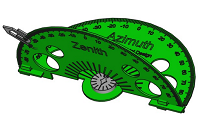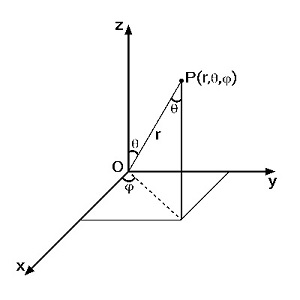The 3D-Compass Interactive Demo

The 3D-Compass is an innovative educational instrument designed to bridge the gap be tween abstract mathematical concepts (spherical polar coordinates) and tangible, real world applications (navigation, astronomy). It consists of two perpendicularly folded semi-circle protractors ( 90 to +90 ), repre senting the Azimuthal ( ) and Polar ( ) angles, along with a magnetic compass for ground alignment

See It in Action: Interactive Demo
Use the sliders to manipulate the spherical coordinates ($\rho, \theta, \phi$) and see the 3D plot and resulting Cartesian ($x, y, z$) coordinates update in real-time. This is the core concept students will master.
Calculated Cartesian Coordinates:
2.50
2.50
3.54
Alignment with Louisiana Student Standards
The 3D-Compass workshop directly reinforces high-priority LSSS and Science and Engineering Practices (SEP) across multiple high school disciplines.
Mathematics
(LSSS: F-TF.A.2 / N-VM.A.1)
Direct application of trigonometric functions and vector analysis (magnitude and direction) in 3D space, moving beyond the unit circle.
Science
(LSSS: HS-ESS1-4)
Practical modeling of orbital motions, celestial targeting, and frame of reference conversions required for astronomy and navigation.
Engineering
(LSSS: HS-ETS1-2)
Core workshop structure utilizes the Engineering Design Process (EDP) to design, test, and optimize solutions, fostering problem-solving skills.
Technology
(LSSS: K-12.CS.A.2)
Computational modeling and abstraction required for cross-convention code and 3D pathfinding (Activity B from the full workshop).
Proposed 90-Minute Workshop Plan
The curriculum is structured around the Engineering Design Process, moving from conceptual understanding to practical, hands-on problem solving.
-
1
Phase 1: Explore & Define
Introduce the need for 3D coordinates. Define the mission: convert a spherical target location to rectangular coordinates for vehicle navigation.
-
2
Phase 2: Learn & Practice
Hands-on use of the 3D-Compass to set angles. Guided practice of the trigonometric conversion formulas.
-
3
Phase 3: Design & Test
Teams solve a unique, assigned target problem, calculate the $x, y, z$ solution, and physically verify the direction on a scaled 3D grid.
-
4
Phase 4: Share & Reflect
Teams analyze challenges, discuss error, and connect the learning to careers in aerospace, cartography, and autonomous robotics.
Assessment & Measurable Outcomes
Assessment utilizes a four-criterion rubric to generate quantitative data on student mastery and conceptual depth.
| Criterion | Description |
|---|---|
| 1. Mathematical Accuracy | Assesses correct application of trigonometric formulas and notation (LSSS: F-TF.A.2). |
| 2. Model Application & Precision | Measures the accuracy ($\pm 1^\circ$ tolerance) and correct physical use of the 3D-Compass instrument (SEP: Developing Models). |
| 3. Engineering Design | Evaluates the stability and functional optimization of prototyped solutions (LSSS: HS-ETS1-2). |
| 4. Conceptual Understanding | Assesses the ability to explain complex concepts, such as the difference between fixed (Equatorial) and dynamic (Horizontal) coordinate systems. |
Recommendation for Next Steps
We propose initiating a pilot program within 2–3 high school math or science departments to gather localized data using the provided rubric and formally demonstrate the instrument's impact on student mastery of LSSS-aligned 3D coordinate concepts.